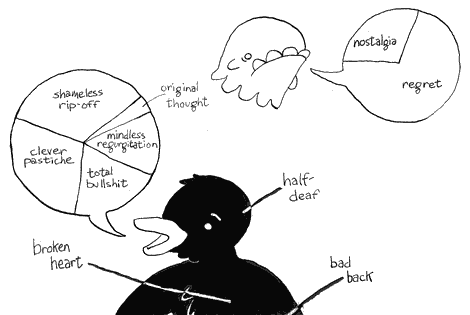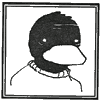· forthcoming
For some reason, I almost never discuss something I'm working on with anyone. I don't know whether it's because I fear early criticism, or simply that I want the work to stand on its own, without people having a preconceived idea of what it is. Francois on the other hand, will speak readily and at length about his (or my) upcoming projects with almost anyone who's willing to listen. Is one of us more right than the other? I don't know, but I've decided that maybe my reticence should be tempered somewhat by openness. With that in mind:
My upcoming self-published comic is entitled "Ochre Ellipse," a phrase I chose solely for its intrinsic beauty. I'm not sure how long I'm going to keep working under that title; right now I have a three-issue "story arc," so to speak, in mind. Themes to be discussed: youth, growth, inevitability, determinism, puissance, power, control, truth, honesty, nature. What I want to do is to build up a sort of lexicon of symbols which represent each of these ideas, so that they would be well-known to the reader in the same way that the tropes of a "Peanuts" strip are familiar, immutable constants.
One way I want to do this is to lay out a series of charts or graphs of different types to explain each metaphor. I did something like this in my comic about myself for the "Family Style" zine:

I've been reading Edward Tufte, and trying to understand the best way to display and design information. But can you chart an abstraction? Can you graph a metaphor? And if so, what's the best way? Am I on the right track?
My upcoming self-published comic is entitled "Ochre Ellipse," a phrase I chose solely for its intrinsic beauty. I'm not sure how long I'm going to keep working under that title; right now I have a three-issue "story arc," so to speak, in mind. Themes to be discussed: youth, growth, inevitability, determinism, puissance, power, control, truth, honesty, nature. What I want to do is to build up a sort of lexicon of symbols which represent each of these ideas, so that they would be well-known to the reader in the same way that the tropes of a "Peanuts" strip are familiar, immutable constants.
One way I want to do this is to lay out a series of charts or graphs of different types to explain each metaphor. I did something like this in my comic about myself for the "Family Style" zine:

I've been reading Edward Tufte, and trying to understand the best way to display and design information. But can you chart an abstraction? Can you graph a metaphor? And if so, what's the best way? Am I on the right track?




2 Comments:
I was almost going to comment in advance on your reluctance to divulge the inner workings of your creations in progress... the other day when I peered over your shoulder at the page you were drawing and I asked "What's that?" & you covered it up with your hand and shooed me away I came away with mixed feelings. I understand a need for privacy and a desire to work undisturbed, but at the same time I'm your friend and artistic peer... Family Style, right?
Does it all comes down to a matter of extroverted vs. introverted, for better or for worse? I show everything to everybody (and not just artistically), which fulfills a need I have for acceptance & positive feedback, and I'm also just excited about it all; but it also causes me to lose any semblance of modesty or patience.
As in everything, there must be a middle road.
Frankly, it's the peering over the shoulder that does it—you know, rather than letting me share if I want to. Also, I think that I don't explain myself or my intentions well, so—case in point, I don't even know what I'm trying to say right now. I guess just that my personal culture is a very private one. I process everything intrapersonally rather than interpersonally.
You know more than anyone else does so far, anyway, so take heart.
Post a Comment
<< Home